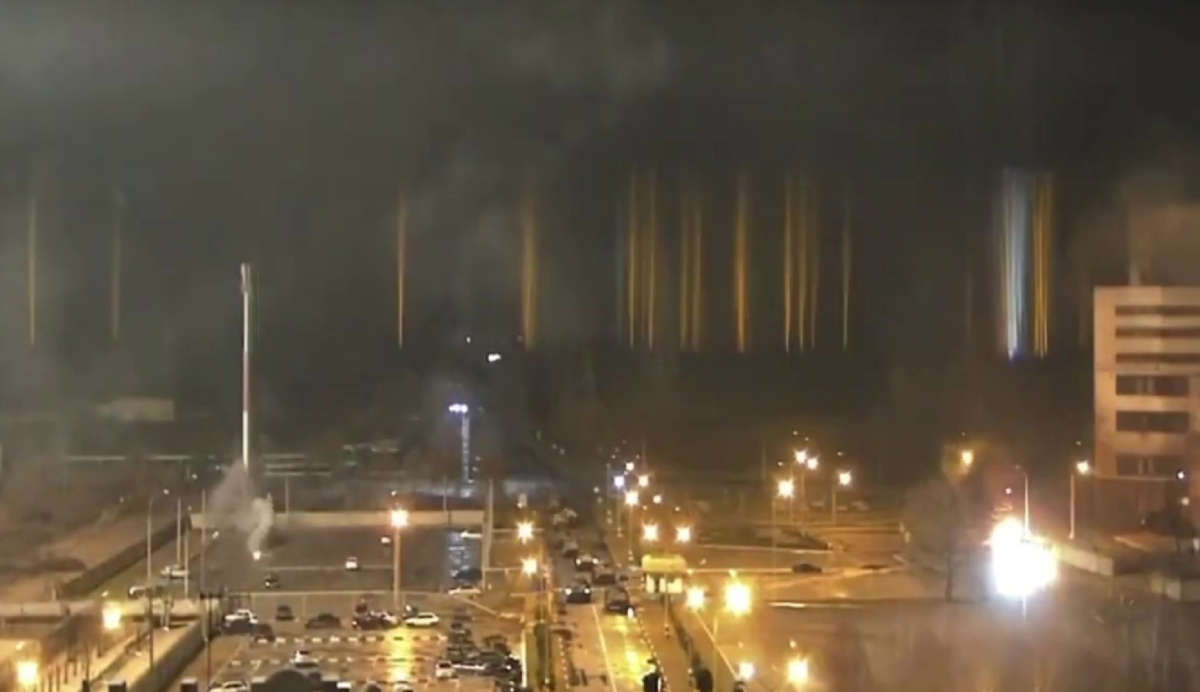Russian forces reportedly seized control of a Ukrainian nuclear power plant on Friday shortly after a fire broke out at the facility, intensifying global fears of a massive and unprecedented radioactive disaster.
The fire, which Ukrainian officials said was sparked by Russian shelling, was extinguished Friday morning, but concerns remained about the potential for a leak of radioactive material if operators at the Zaporizhzhia nuclear plant are unable to safely cool power units at the site.
During a press conference Friday morning, the head of the International Atomic Energy Agency (IAEA) said the blaze started after a “projectile” hit a building within the plant complex.
“The physical integrity of the plant has been compromised,” said IAEA Director-General Rafael Grossi, who stressed that the safety systems of the six nuclear reactors at the site were not affected by the fire and that the plant’s radiation monitoring infrastructure remains “fully functional.”
As of yet, Grossi said, there has been no release of radioactive material. He added that as of Friday morning, a Ukrainian staff was still running the nuclear plant even after the Russian military took “effective control” of the site.
In a televised address on Friday, Ukrainian President Volodymyr Zelenskyy accused Russia’s military forces of engaging in “nuclear terror” and called on the Russian people to “take to the streets and say that you want to live, you want to live on Earth without radioactive contamination.”
“Radiation does not know where Russia is, radiation does not know where the borders of your country are,” Zelenskyy said, echoing concerns that the release of radioactive material could impact huge swaths of Europe, potentially rendering them uninhabitable for decades.
The Russian Defense Ministry, for its part, blamed “a Ukrainian sabotage group” for the fire at the Zaporizhzhia plant.
The world watched in horror overnight Friday as the Zaporizhzhia complex — the largest nuclear power facility in all of Europe — came under attack, a scenario that scientists and campaigners have been sounding alarms about since before Russia launched its full-scale invasion of Ukraine last week.
“Fire is the biggest risk for core melt at a nuclear power plant. This is the biggest nuclear power plant in Europe,” the advocacy group Beyond Nuclear tweeted as reports of a blaze at the facility were confirmed. “We are perched on the precipice of catastrophe.”
U.S. Sen. Ed Markey (D-Mass.) voiced similar fears, declaring that “Russia’s horrifying attack on the Zaporizhzhia nuclear plant could result in a nuclear disaster spanning hundreds of square miles in all directions.”
“Fallout doesn’t respect borders. This would be an international war crime by Putin that could result in incredible devastation,” said Markey. “First responders and nuclear safety personnel must be allowed to immediately address the situation at Zaporizhzhia. If this disaster is allowed to worsen then Putin will be putting his own people and those in countries across Europe at terrible risk.”
In a series of Twitter posts, Matthew Bunn, a professor at the Harvard Kennedy School and a co-principal investigator at the Project on Managing the Atom, denounced Russia’s alleged shelling of the Zaporizhzhia complex as “shockingly reckless, and a violation of multiple agreements.”
“The member states of the IAEA unanimously agreed years ago that attacking a nuclear power plant ‘constitutes a violation of the principles of the United Nations Charter, international law, and the Statute of the Agency,'” Bunn observed. “This shelling COULD cause a major radioactive release, but it’s too soon to tell whether (a) that will happen, (b) that’s what Russian forces intended, or (c) if it does happen, how big the release will be.”
Among other significant risks, Bunn highlighted the possibility that continued shelling could endanger the facility’s pools of spent nuclear fuel. Greenpeace International noted in an analysis earlier this week that, as of 2017, 855 tons of spent fuel were stored in the six pools at the Zaporizhzhia complex.
“If the fuel building was shattered by shelling, then any fission products released from the melted fuel could get out into the surrounding countryside,” Bunn warned. “Shelling could also cause a water leak that could lead to fuel melting, even if the electricity stayed on.”
“IF the fuel pool is really overstuffed with spent fuel, AND the hot fuel assemblies recently discharged from the reactor are stored next to each other (rather than interspersed throughout the pool) the fuel can get so hot it catches fire — that, plus a shattering of the building, is really the worst-case scenario,” he added. “That could release a quantity of radioactivity even worse than Chernobyl, potentially.”
Join us in defending the truth before it’s too late
The future of independent journalism is uncertain, and the consequences of losing it are too grave to ignore. To ensure Truthout remains safe, strong, and free, we need to raise $46,000 in the next 7 days. Every dollar raised goes directly toward the costs of producing news you can trust.
Please give what you can — because by supporting us with a tax-deductible donation, you’re not just preserving a source of news, you’re helping to safeguard what’s left of our democracy.
